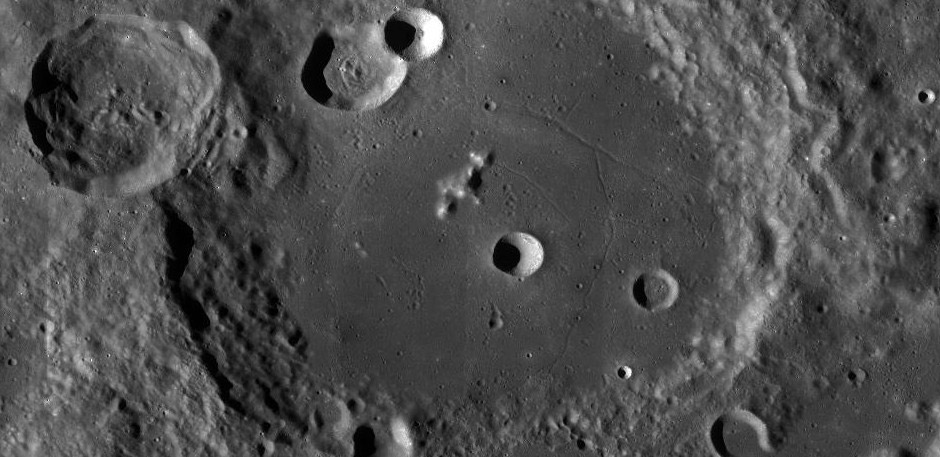
Lunatic’s Corner: Crater Cleomedes
April 2023 :
Cleomedes is a floor-fractured, complex impact crater just north of Mare Crisium in the northeast quadrant of the moon. It is one of the largest craters north of Mare Crisium with a diameter of about 80 miles and a depth of 1.7 miles. Cleomedes is an interesting observing object in that it has many features visible in amateur telescopes. Terraced walls, central peaks, network of rilles, and craterlets are just some of the features greeting the discerning eye of the observer. Cleomedes is visible at the terminator around Lunar Days 4 (waxing crescent) and 17 (waning gibbous).
The central peaks of Cleomedes are somewhat off center of the crater which might indicate an oblique angle of impact, or the remnants of peaks buried in subsequent lava flows. The relatively low peak height (<5000 ft.) gives a further indication of possible hidden structure. A prominent Y-shaped rille, called Rima Cleomedes runs from north to south along the eastern side of the crater and was most likely formed by igneous intrusion given its proximity to Mare Crisium. The smooth floor of Cleomedes can be attributed to lava flows infiltrated from Mare Crisium through the worn and broken southern rim. Crater Tralles interrupts the northwest wall of Cleomedes, spilling debris onto the crater floor
The crater also contains several prominent craterlets. Cleomedes E, close to the northern rim is an interesting object. In high resolution photos, rilles can be seen on the crater floor. Given what we know about the formation of floor fractured and concentric-ringed craters, (see previous article on Hesiodus A, October 2023) Cleomedes E seems to be a hybrid of both types of craters.
The Greek astronomer Cleomedes is the namesake of our subject crater. Aside from his simplified textbook ‘On The Circular Motions of Celestial Bodies’, not much is known about Cleomedes. Even the dating of his work is uncertain, with some historians give dates between 50 B.C. and 400 A.D. However, most scholars agree on a publishing date within the 1st century A.D.
A disciple of Posidonius, Cleomedes wrote a disclaimer in the book that it contained a summary of the work primarily of Posidonius, but also of some other astronomers, and is not an original work of Cleomedes. The greatest value of this book is that it apparently quotes Posidonius almost verbatim. Posidonius was an ancient astronomer whose work did not survive to modern times.
Cleomedes’ book also gave a detailed account of the method utilized by Eratosthenes to measure the circumference of the earth and is the primary way in which we know this method today. Cleomedes also wrote accurately about the Sun and Moon Illusion (both look larger at the horizon than at the zenith) and how it is caused by atmospheric diffraction and apparent distance hypothesis which he credits to Posidonius. He also remarked that the absolute size of many stars may be much larger than the sun and how the earth might look like a small star from the surface of the sun.
Cleomedes was a remarkable fellow and has left us important information about ancient astronomy. His namesake crater is also remarkable in the variety of interesting features it contains. Both are worthy of our attention and deserve a place on our list of objects to observe.
Michael Corvese is a confirmed lunatic of many years regardless of his recent interest in lunar observing.



